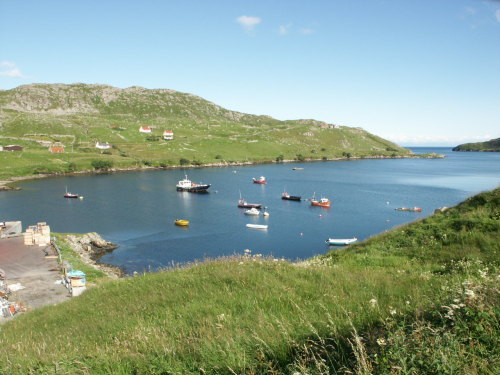Lemreway
From the Place Names of Lewis and Harris, D Maciver:
Leumra: This is the name used long ago by the old people. Some say to-day Leumrava. The terminal rà here has the same meaning as the second terminal và, a corner of land, an elbow. It does not mean bay. The loch is a fine harbour. It has a corner called Ard-an-eisg, where fish used to be landed, a rock suitable for landing, hladhamara, a landing rock; leur, mud, does not apply.
Lemreway was let by 1776 to a Stornoway merchant, Norman Macleod; by 1790 the tack has passed to his brother Murdo, and by 1795 to their cousin Kenneth Macleod. The Shiant Isles were originally included in this tack, and later it was combined with Steimreway.
At the time of the clearance of the village in 1843 in had a population of approximately 180. Three women were left in the cleared village of Lemreway, one of whom was known as Barbara Saxon (Barabara Shasannach).
Peter Sellar (son of Patrick, the efficient evictor of Sutherland tenants) was responsible for the clearance and the village remained cleared for fifteen years until a deal was made which resulted in the status of Lemreway being reversed. People were allowed to resettle in the village from the late 1850s, and many from Steimreway, cleared in 1857, also moved to Lemreway then.
The people who left moved mostly to Crossbost, some went to Glen Tolsta and of course some emigrated. The returning people came mostly from Balallan, Gravir, Marvig and one family, the Montgomeries, from Ranish. The families from Steimreway were Nicolson, Macmillan, Macinnes, Ferguson and a Donald Martin. Four families from Lemreway (Peter Chisholm No 9, Donald and John Nicolson No 16 and Donald Carmichael No 26) settled in Steimreway in 1922, though that settlement was short-lived.
The remains of the corn mill can be seen beside the stream down near the shore. Beside the mill are the remains of the kiln, used for drying grain. There was a shop at the shore run by Donald Kennedy, An Ceannaich. His predecessor John Macleod, Iain an t-Saoir, went to Canada but eventually returned to the Island and settled in Stornoway. Flora Nicolson had the next shop, next to #24.
A drifting mine exploded on the shore in 1941. The blast was so powerful that it blew in the windows of Peter Macinnes’s house, and five boats on the shore were also blown to matchsticks.
Families in Lemreway resided at the following crofts; these refer to the re-settlement.
Booklet available
Lemreway genealogy on Hebridean Connections.
